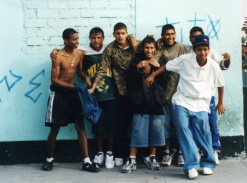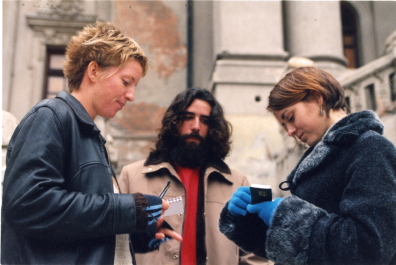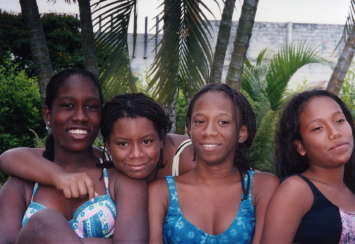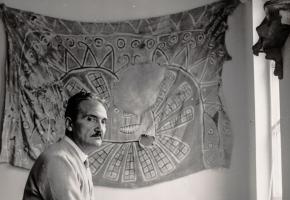It was the perfect job for a restless twenty-six year-old. I was in Miami, on my way to a desk-job in Britain after four years working as a journalist in Argentina, when Levi Strauss approached me. I would spend a month each in ten Latin American cities, investigating their youth cultures. At the end of each month, in a base of my choice, I would write the reports. Would I mind!? I’d had to have a screw loose to refuse such an offer.
And so it was, a handshake over the sparkling rim of a sun-kissed Cosmopolitan and a week later, that Britain became a blip on the landscape of lost fate and I was descending over the mist of Peru’s granite coastline. Levi’s had said they wanted the thoughts and feelings of youth, to gage the emotional and psychological state of “the market.” There was no option but to dive in. I loitered around schools, parks and shopping malls before introducing myself, a gringo writer, to unsuspecting youngsters. Stripped of Miami’s pink reflected womb-like warmth, I felt naked and scared. The kids would stare at me, jaws hanging in disbelief. Me, interview them? What for? But then I ask them who they would interview if they had the choice. They would smile and I could almost hear their imaginations begin to tick – tick tock, tick tock. Maradona, Che Guevara, the Pope… I would ask them what last made them angry, or gave them joy, what they hated about their country, what they loved, what they thought about most often. How they talked! It seemed nobody had ever asked them anything about their lives.
Sometimes I would spot a group of boys who looked like regular teenagers from afar, but up close their faces bore the lines of men weathered by life, and their eyes were glazed, but wide open and darting around. The chemical smell ofpastabase was so overpowering I had to hold my stomach tight to stop myself vomiting. I would try to ask questions, but they just stared at me, start a sentence and stop midway, incapable of finishing. In the main, though, the kids’ stories and self-deprecating humour dispelled the depressing chaos of a third world megatropolis. The more kids I interviewed (around 800 – in groups ofcourse), the more I was fascinated by the details that made each one of them different. They never once questioned me or asked me to explain myself. Their trust was astonishing, and I began to feel uneasy.

Back in Miami, as gold on shaved, hormone-puffed chests flashed by my hotel window, the sullen yet generous Limeño faces floated by in my mind, with their dreams and vulnerabilities, mouthing words like “We don’t want to be American, we want to be like we are but with more money.” Levi’s wanted tribes, however, in the form of bullet points, and coloured circles on grids. I pretended it was a game, and started sectioning them up: the Surfers who wanted to wash off reality on the waves; the Cholo-bohemios who needed to explore Peru’s defeat through poetic expression, while thePatas found no comfort sweeter than telenovelas. I slapped their coloured balls down on the grids labelled with adjectives like optimist-pessimist or consuming-participating.
It was in Panama – amidst the comforting Caribbean hustle and bustle of swaggering café-con leche skinned boys - that my history lessons began. My young interviewees told me of an era of hope and ideals in the Seventies before every peasant community and union movement in Central America had been crushed by US backed troops, and the corrupt elites restored. Panama, having been a US base and “client state” from inception, had never got the chance to rebel as much as her neighbours. Did Levi’s arrival here mark a reward for that obedience? Did it somehow transform the defeated ideals into first world status? I asked myself. What process was my job part of? What conditions had brought me here and what was I contributing to? The questions began to roll.
I had my Salsa to distract me. My young Latinas had been instructing me in the arts of entrega – a feminine submissiveness and precondition for love that I apparently lacked. Salsa teaches you this, they said. Perhaps they referred to the executive WASPy woman in my Miami classes who developed a frown during a complicated move and would stop in the middle of the music to show her partner how it should be done. It was difficult to submit to John, though, the American who went through two changes of shirt in an hour, and gave me a face spray everytime he spinned.
In Caracas, practicing behind the swing of those robust Cara-curves, reality intruded yet again. You could have mistaken this oil-rich city of motorways and skyscrapers for Miami were it not for the Ranchos, stacked shacks clinging to the surrounding hillside like humans clambering to heaven.“What we need is another mudslide to get rid of them,” said one well fed Sifrino(posho) on the lawn of a private university, annoyed that this stain ruined his illusion of living in Miami.
And yet, even in the Ranchos, which one heavy rainfall could tumble again like it did two years before, killing 50,000 people, mobile phones, TV, the latest brands were considered essential acquisitions – a defence against precariousness perhaps. Never had I seen so many billboards. They tempted the Ranchos with pieces of a dream that had been accessible in the early 70s, when the oil boom gave Venezuelans hope for real progress. That dream ended when foreign car manufacturers (Ford and General Motors) convinced corrupt local politicians and industrialists to open the market to foreign imports rather than use the petro-dollars to build a national automobile industry. Now it seemed that the 80% living in poverty clung to this faded hope of first-worldness through sacraments; a pair of jeans, a hamburger, a pair of Nike.

And it suddenly occurred to me that I was like a modern-day priest, collecting confessions for marketing strategies that converted vulnerabilities into consumer desire, and sold salvation through brands. “Just be” for youth still searching its identity, “Just do it” for a youth wanting opportunity. But who was going to help them achieve the real opportunities they craved? The very neo-liberal process that opened up opportunities for multinationals (even me) had eroded theirs.
Down, down I kept going into the belly of this enthralling beast. You couldn’t get more intense than Colombia, her astonishing beauty trapped in a 60-year civil war. On the streets of Medellin, order had been restored by the recent hardline governor Alvaro Uribe, my local Levi’s boss reassured me, making it safe for investors. But, pointing to the thick set beedy-eyed lads loafing on the street corner, Raul said “ Pablo Escobar was no saint, but atleast he helped the poor, these thugs (the paramilitaries) that now rule just protect the rich.” The joint army-paramilitary operations that Uribe orderd to roots out left wing subversives had left the ‘Paras’ in control. Official assasination numbers were down. Now, people - human rights defenders, trades unionists - just ‘disappeared’.
At night in Templo Antonia disco, thousands of couples clung, swaying to the rythmn of the Vallenatos as if it were their last embrace. In the morning the Vallenateros repented their sins in Church, while in downtown hideaways the charcoal- smudged-eyed Metaleros flung their hair at screeching guitar sounds. “If we were taught to show our anger rather than hide our violence in their lovey-dovey ballads there would be less killing here”, said one half-skinhead half-metalhead youth.
And yet, in the cracks of a place cemented by vengeance and rage, lay sweet tender voices enamouring you of the most mundane details of life – a glance, a gift, an invitation, a greeting, a goodbye – as though they were the most precious things in the world. Every second one had to choose, right from wrong, good from bad, which side to be on. Lost in this labrynth of confusions, I saw new clarities and truths.
By the time I had to present “the youth tribes of Latin America” to Levi’s executives back in Miami, I had chosen my side. As the executives leered at the slides of children, touched by their emotions, like the farmer who adores the lambs he (alas) sends to the abbatoirs, I was tempted to add other tribes – racist marketing managers, greedy executives, thoughtless strategists. No now was not the time. The question was, how to continue my journey.
Down, down again to the “dagger pointing to the Antarctic.” That was how US Secretary of State Henry Kissinger described Chile in 1972 when it democratically elected Latin America’s first ever Socialist president. He soon helped General Pinochet topple him. I found a people whose soul had been ripped out, replaced by imitation America. The Andes’ faint majesty behind Santiago’s smog - a reminder of the Chile lost. It was a city divided between the Losers, who parents and uncles had been tortured and killed, for capitalism and the Winners, Pinochet’s yuppie children (my market). Strange that it was the latter who seemed filled with hate, as if the very presence of the Losers reminded them of something unpleasant.
And so back to Buenos Aires, 30 years after my birth. I had left Levi’s and Levi’s were leaving Argentina. The acclaimed neo-liberal plan had collapsed. As foreign investment investors fled and banks seized ordinary people’s savings as collateral, over night respectable middle-class women became bag-ladies, rummaging the dustbins of Plaza San Martin. “Is this what we murdered a generation for, for this?” an old man shook his head. And yet, even while picking up the pieces from the debris, classes that previously hated each other became united and a new generation were more determined than ever to reclaim their destiny.
On my journey through Latin America I had learnt many things. That Brands don’t reflect or serve desires, they manipulate and transform truths. Through their sheer economic power they are able to turning real meanings into “cool” things, devoid of meaning. Ideals = desire. Identity = aspiration. Principles = status. Consciousness = greed. I learnt that market forces are not natural expression of popular desire, but a political process imposed by corrupt political and business elites reinforced by military force.
Every single country I had visited with Levi’s had, thirty years ago, either governments’ that were trying to break US hegemony or popular movements that had grown so strong their governments’ couldn’t ignore them. Then the storm clouds of US backed dictatorships, corruption and wars closed in to suffocate. In no country was the neo-liberal model voted for or implemented democratically.
Most of all I saw the incredible power of the human spirit, and the ability of ideals and solidarity to prevail. As Violeta, the “loser” sitting on the side of the park in Santiago, told me.“They killed our parents, but they haven’t killed us. Our parents’ ideals live on in us. That is our victory.”
Amaranta Wright’s book Ripped and Torn: Levi’s Latin America and the Blue Jean Dream (Ebury) is available in English fromwww.amazon.com and in Spanish from www.casadellibro.com

















